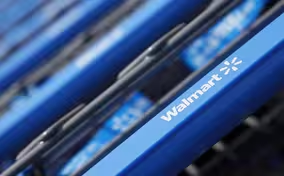
What’s in the new U.S.-EU trade framework announced by Trump
Clip: 7/27/2025 | 5m 18sVideo has Closed Captions
What to expect from the new U.S.-EU trade framework announced by Trump
In Scotland on Sunday, Trump and the European Union announced a major trade deal between their two massive economies. The framework for the preliminary deal includes a 15% general tariff on most EU goods entering the U.S. while a 50% tariff on steel and aluminum remains in place. Lisa Desjardins speaks with David Lynch, global economics correspondent at The Washington Post, to learn more.
Problems playing video? | Closed Captioning Feedback
Problems playing video? | Closed Captioning Feedback
Major corporate funding for the PBS News Hour is provided by BDO, BNSF, Consumer Cellular, American Cruise Lines, and Raymond James. Funding for the PBS NewsHour Weekend is provided by...

What’s in the new U.S.-EU trade framework announced by Trump
Clip: 7/27/2025 | 5m 18sVideo has Closed Captions
In Scotland on Sunday, Trump and the European Union announced a major trade deal between their two massive economies. The framework for the preliminary deal includes a 15% general tariff on most EU goods entering the U.S. while a 50% tariff on steel and aluminum remains in place. Lisa Desjardins speaks with David Lynch, global economics correspondent at The Washington Post, to learn more.
Problems playing video? | Closed Captioning Feedback
How to Watch PBS News Hour
PBS News Hour is available to stream on pbs.org and the free PBS App, available on iPhone, Apple TV, Android TV, Android smartphones, Amazon Fire TV, Amazon Fire Tablet, Roku, Samsung Smart TV, and Vizio.
Providing Support for PBS.org
Learn Moreabout PBS online sponsorshipLISA DESJARDINS: Good evening.
I'm Lisa Desjardins.
John Yang is away.
We are tracking two major stories tonight in Gaza and in Europe.
We begin in Scotland, where President Trump and the European Union announced a major trade deal between their two massive economies companies.
DONALD TRUMP, U.S. President: We were able to make a deal that's very satisfactory to both sides.
So it's very, it's a tremendously, it's a very powerful deal.
LISA DESJARDINS: The framework for this preliminary deal includes a 15 percent general tariff on most E.U.
goods entering the U.S. a 50 perent tariff on steel and aluminum would remain in place.
In addition, Mr. Trump said the E.U.
has agreed to buy some $750 billion in U.S. energy and invest hundreds of billions of dollars more.
A much higher general tariff, 30 percent, was due to go into effect later this week.
David Lynch is a global economics correspondent at The Washington Post.
He's also the author of the "World's Worst Bet: How the Globalization Gamble Went Wrong and What Would Make It Right."
David, let's start.
First of all, the U.S. is charging a 15 percent tariff from this preliminary deal with the idea of easing the U.S. trade deficit with the EU.
What U.S. industries withstand to gain from this?
DAVID LYNCH, The Washington Post: Well, I think we should start by saying this is really a bold departure from decades of U.S. trade policy that's been aimed at lowering trade barriers.
This new 15 percent tariff or tax is something that American companies will have to pay to import European products.
So it's going to raise prices for some American customers.
We don't know exactly to what extent, but prices will go up, not down.
Now that will affect anybody who brings in any European good in the auto industry and the aircraft industry, you know, French wines, you name it.
This is going to affect anything that comes in from Europe.
LISA DESJARDINS: And how about the reverse?
The president likes to talk about the auto industry trying to make gains in Europe.
Does that seem feasible or what does the US and what industries stand to get to benefit there?
DAVID LYNCH: Well, the problem -- the president has complained frequently about European tariffs on raising the price of American cars that Detroit's Big Three would be trying to sell on the continent.
The problem is the American automakers specialize in larger vehicles, big sport utility vehicles of the kind that are quite common here, obviously, and pickup trucks like the Ford F150.
And many Europeans say those vehicles just aren't suited for the tight confines of European cities like Paris and Brussels and other places.
So it's not entirely clear just how much of a potential upside there is for the American automakers in Europe.
And there are concerns on this side of the Atlantic about whether all of the various planks of the president's trade policy really fit together.
LISA DESJARDINS: You said that part is not clear.
But I want to ask you, is it even clear that all of this deal is set in stone?
For example, President Trump has said that Europe will no longer charge any tariffs on American goods, but Europe, from my understanding as we speak, has not confirmed that.
How certain is this deal?
DAVID LYNCH: Yeah, I would say not certain.
We've seen a number of occasions where the president has gotten out ahead of formal announcements and has announced some of these framework trade agreements, either with the Truth Social post or press conference or remarks to reporters, and has claimed that items have been agreed or provisions have been agreed that we subsequently find out are not quite agreed to that extent.
We've seen that in his discussion of planned Japanese investment in the United States, in the tariff rate on Vietnamese products, on the applicability of the tariff rates with Indonesia.
And so the White House has not made public the sort of detailed text of trade agreements that we've seen in the past.
And before I think we can render final judgments on any of these, we need to see more paper.
LISA DESJARDINS: Quickly in our last seconds.
Do you believe this establishes a 15 percent tariff as perhaps Trump's standard?
Should we be looking at that going forward?
DAVID LYNCH: Yeah, I think so.
He's - - there've been two sets of tariffs that he's had in mind since his April 2nd announcement.
One is the sort of universal or baseline tariff that will apply to all $3.3 trillion worth of merchandise that we bring into the country from overseas.
He's talked about that at 10 percent initially.
More recently, I think after seeing that the financial markets took that in stride and he's up the levy to 15 percent.
And I do think we're going to see that as sort of the, you know, the cover charge for getting into the American market.
LISA DESJARDINS: David lynch of the Washington Post, thank you.
DAVID LYNCH: Anytime.
How national park funding cuts may harm local communities
Video has Closed Captions
Clip: 7/27/2025 | 7m 31s | How funding cuts to national parks may harm the communities around them (7m 31s)
ICE agents wearing masks creates opportunity for imposters
Video has Closed Captions
Clip: 7/27/2025 | 4m 35s | Rise of ICE agents wearing masks creates opportunity for imposters to conduct crimes (4m 35s)
Israel increases food aid to Gaza amid reports of starvation
Video has Closed Captions
Clip: 7/27/2025 | 4m 23s | Israel increases food aid to Gaza amid outrage over growing reports of starvation (4m 23s)
News Wrap: 6 in critical condition from Walmart knife attack
Video has Closed Captions
Clip: 7/27/2025 | 1m 53s | News Wrap: Michigan Walmart knife attack leaves 6 in critical condition (1m 53s)
Providing Support for PBS.org
Learn Moreabout PBS online sponsorshipSupport for PBS provided by:
Major corporate funding for the PBS News Hour is provided by BDO, BNSF, Consumer Cellular, American Cruise Lines, and Raymond James. Funding for the PBS NewsHour Weekend is provided by...















